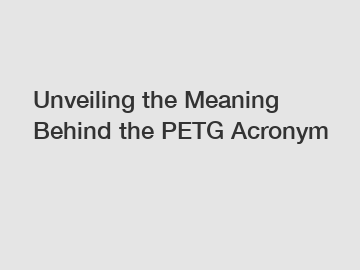When it comes to the world of plastics, there are countless acronyms that can leave many people scratching their heads. One such acronym that has been gaining popularity in recent years is PETG. But what exactly does PETG stand for and what is its significance in the world of materials science?
PETG is short for polyethylene terephthalate glycol-modified, which is a type of thermoplastic polymer resin that is commonly used in a variety of applications. This versatile material is known for its transparency, impact resistance, and ease of processing, making it a popular choice for everything from food packaging to 3D printing.
The "P" in PETG stands for polyethylene, which is a type of polymer that is derived from ethylene, a gas that is produced from natural gas or petroleum. Polyethylene is one of the most widely used plastics in the world, thanks to its low cost, versatility, and durability. In the case of PETG, the addition of terephthalate and glycol modifications gives the material additional properties that make it ideal for certain applications.

Terephthalate is a type of chemical compound that is commonly used in polyester fibers and resins. When added to polyethylene, terephthalate helps to increase the material's strength and heat resistance, making it suitable for applications where traditional polyethylene may not be as effective. The glycol modification, on the other hand, helps to improve the material's impact resistance and flexibility, making it less prone to cracking or breaking under stress.
One of the key benefits of PETG is its transparency, which makes it an ideal choice for applications where visibility is important. Unlike some other plastics that can become cloudy or yellow over time, PETG maintains its clarity and color stability, even when exposed to harsh conditions. This makes it a popular choice for products such as retail displays, medical devices, and protective face shields.
In addition to its transparency, PETG is also known for its impact resistance, which is significantly higher than that of traditional polyethylene. This makes it a popular choice for applications where durability is important, such as protective packaging or industrial components. PETG is also resistant to many chemicals, making it suitable for use in environments where exposure to harsh substances is a concern.
PETG is also easy to process, which is another reason why it has become a popular choice for manufacturers. The material can be easily molded, extruded, and thermoformed, allowing for a wide range of shapes and designs to be created. This versatility makes PETG suitable for a variety of applications, from injection-molded parts to 3D printed prototypes.
In recent years, PETG has become increasingly popular in the world of 3D printing, thanks to its ease of use and durability. Unlike some other materials that can be difficult to work with, PETG is known for its ability to adhere to build plates and withstand the high temperatures and pressures of the printing process. This makes it an ideal choice for hobbyists and professionals alike who are looking to create high-quality, functional parts.
Overall, PETG is a versatile material that offers a wide range of benefits for manufacturers and consumers alike. From its transparency and impact resistance to its ease of processing and durability, PETG is a material that is sure to continue gaining popularity in the years to come. So the next time you come across the acronym PETG, you'll know that it stands for much more than just a few letters – it represents a material that is shaping the future of plastics.
If you want to learn more, please visit our website recyclable shrink films, medical petg film, bopla film.
Comments
Please Join Us to post.
0